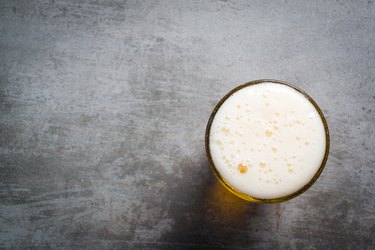
When you enjoy a glass of wine or a cocktail with your dinner, you're probably not focused on the alcohol calories per gram. However, be aware that alcoholic beverages can easily rack up empty calories.
Tip
1 gram of alcohol contains 7 calories, states Harvard Medical School. This energy content approaches that of fat, which packs 9 calories for each 1-gram serving.
Video of the Day
View Alcohol Calories per Gram
When noting an alcoholic beverage's alcohol calories per gram, consider that the drink provides empty calories with no nutritional benefits, says Harvard Medical School. Alcohol contains 7 calories for each gram consumed, which closely mirrors 9 calories per gram of fat.
Video of the Day
Besides directly increasing your caloric intake, drinking alcohol with a meal can cause you to consume more food. Researchers think that alcohol may lower your inhibitions so you're less concerned about ordering a dessert or extra drink. It's also possible that alcohol can alter your brain chemistry so you receive increased rewards from the food you eat.
If you'd like to measure your alcohol consumption in alcohol calories per ml, or milliliter, that's easy to do. According to the U.S. National Library of Medicine, each alcoholic beverage's calorie content depends on its serving size, which is measured in both ounces and milliliters. To determine the alcohol calories per milliliter, simply divide the drink's calories by its milliliters.
Standard Alcoholic Drinks and Calories
Learning the definition of a standard alcoholic drink will also help you to count your alcoholic beverage calories. The Mayo Clinic states that a standard alcoholic drink typically contains 14 grams of alcohol. For reference, that's 1.5 ounces (or one shot) of 80-proof distilled spirits. A 12-ounce bottle of beer, or a five-ounce glass of wine, provides the same amount of pure alcohol.
However, some beverage containers can hold more than one standard drink. For example, some wine glasses have more than a 5-ounce capacity, and drinking an 8-ounce portion of wine can sneak lots of extra calories into your diet. That extra alcohol consumption could provide an unwelcome surprise when you get on the scales.
Read more: Calories in Liquor List
Alcoholic Beverages with Fewest Calories
If you'd like to minimize the effect of alcoholic beverages on your diet, consuming lower-calorie drinks makes sense. The U.S. National Library of Medicine presents options in three alcoholic drink categories.
A 12-ounce light beer has only 103 calories, while the same-size regular beer has 153 calories. Craft and higher-alcohol beers can pack in 170 to 350 calories per bottle.
In the wine category, a 5-ounce glass of pinot noir has only 121 calories. A similar glass of Burgundy, cabernet sauvignon or merlot comes in at 122 calories, while red and white table wines also fall into the range of about 120. In the distilled alcohol category, 80-proof gin, vodka and whiskey each have 97 calories for a 1.5-ounce (or one shot) glass of the distilled spirits.
Read more: 9 Scary Side Effects of Social Drinking
Alcohol’s Link to Belly Fat
If you've been troubled by annoying belly fat, you might wonder if alcohol consumption can add to the problem. The Cleveland Clinic explains that belly fat results from consuming too many calories from any source (including alcoholic beverages).
If your liver is tasked with burning alcohol and fat at the same time, it always chooses the alcohol — so your efforts to burn fat and lose weight receive a setback when alcohol is brought into the picture.
Generally speaking, men tend to stockpile more fat in their bellies. Although women store some fat in their abdomens, fat also piles up in the women's arms, buttocks and thighs. As part of the aging process, both men and women are more prone to belly fat accumulation.
Specifically, the existence of a "beer belly" results in a higher risk for hypertension, heart disease, high cholesterol and type 2 diabetes. Metabolic syndrome and fatty liver disease could also develop. Belly fat has also been associated with higher mortality.
Read more: Does Drinking Alcohol Slow Your Metabolism?